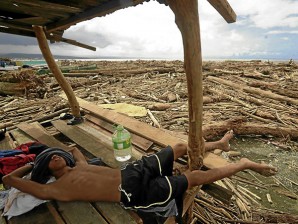UN exec on ‘Sendong’: It’s like a tsunami hit

SLEEPING LIKE A LOG A boy dozes off amid a sea of logs that were washed up by rampaging floodwaters spawned by Tropical Storm “Sendong” in Iligan City on Dec. 16. Thousands of homes were destroyed and entire villages along the coast were flattened. AFP
ILIGAN CITY—A United Nations official on Thursday likened to a tsunami the weekend flooding that devastated the cities of Cagayan de Oro and Iligan.
A UN humanitarian coordinator, Soe Nyunt-U, also voiced concern about the possibility of disease outbreaks among the thousands living in evacuation centers after their houses were washed away last Friday when Tropical Storm “Sendong” unleashed flash floods.
“It was as if the cities were hit by an inland tsunami,” Soe told reporters in Manila. “Entire areas were completely flattened. Only a few sturdy buildings remain standing, and these had sustained a lot of damage.”
“Debris from houses, buildings and other structures that had been destroyed by the storm was all swept out to the sea, leaving huge areas devoid of all traces of habitation,” he said.
About 45,000 displaced are inside evacuation centers, most of them in worst-hit Iligan and Cagayan de Oro, home to nearly a million people. Another 266,000 are being assisted outside temporary shelters. Nearly 30,000 houses were destroyed and damaged.
Local authorities and grieving relatives were moving ahead with dozens of burials each day, after a handful of funeral parlors complained they were overwhelmed and could no longer accept bodies, which were still being retrieved from the sea or mud almost a week after the disaster struck.
Cholera outbreak
Aid workers rushed in relief supplies, but a lack of running water was a major concern.
“We must improve this situation at the soonest possible time to avoid disease outbreaks that will further compound the hardships of the people already weakened by hunger and grief from loss of family and friends,” Soe said.
He mentioned a cholera type virus that may occur due to problems stemming from congestion in the evacuation centers, where poor sanitation and hygiene posed a health risk.
The National Disaster Risk Reduction and Management Council (NDRRMC) put the death toll at 1,010 and 51 missing.
However, Mayor Lawrence Cruz of Iligan said that in his city alone, more than 400 residents had been reported missing, with another 283 confirmed dead.
“We could only assume they are dead already. There is so much mud that has to be cleared up and maybe the missing are buried deep inside,” Cruz said.
The Philippine National Red Cross chief, Gwendolyn Pang, said that at least 900 bodies had been recovered and that some 400 people were reported missing.
“Many will never be found and we don’t know how many are really missing. No one will report them because entire families were swept away,” Pang said.
Search for 2 more weeks
NDRRMC Executive Director Benito Ramos said Coast Guard and Navy vessels had been drafted for a huge rescue effort to find bodies floating amid debris up to 100 kilometers away.
“By this time, there will be no survivors, just dead bodies,” Ramos said after Sendong—international name: Washi—brought heavy rains that spawned flash floods, overflowing rivers and mudslides that buried bodies or swept them into the sea.
He said the search could continue for two more weeks.
A Navy vessel recovered 11 badly decomposed bodies off the coastal town of Salay on Wednesday, said Lieutenant Colonel Omar Tonsay, a Navy spokesperson.
“Recovering bodies at sea is difficult because of the sheer volume of debris. You have to ram logs and risk holing your hull or entangling your propellers,” Tonsay added.
On Wednesday, a National Bureau of Investigation team attempting to identify unclaimed bodies moved its operations from a sanitary landfill to a hangar owned by National Power Corp. following complaints from residents that authorities were disrespecting the dead.
Some 70 decomposing bodies have been brought to the garbage dump after funeral parlors said they could no longer accommodate them.
Damage to schools
The Department of Education said the storm caused an estimated P60 million in damage to 36 schools mostly in Cagayan de Oro and Iligan.
Assistant Education Secretary Reynaldo Laguda said the department was working to bring normalcy back in the affected schools when classes resume in January after the Christmas break.
Senator Loren Legarda urged authorities to strengthen mechanisms to help children in evacuation centers.
“Every time a disaster occurs, the impact on children is more likely to be greater because aside from being unable to immediately respond to natural hazards, they are also vulnerable to the aftermath of disasters, including the outbreak of diseases, lack of food, potable water and shelter,” Legarda said.
Also on Thursday, leftist groups marched on Mendiola to hit Malacañang’s lack of preparedness in coping with disasters. “How many more will die,” streamers declared.
The groups said President Benigno Aquino III should be held accountable for his failure to control mining and logging activities. With reports from AP, AFP, Karen Boncocan, Tarra Quismundo and Cathy Yamsuan














